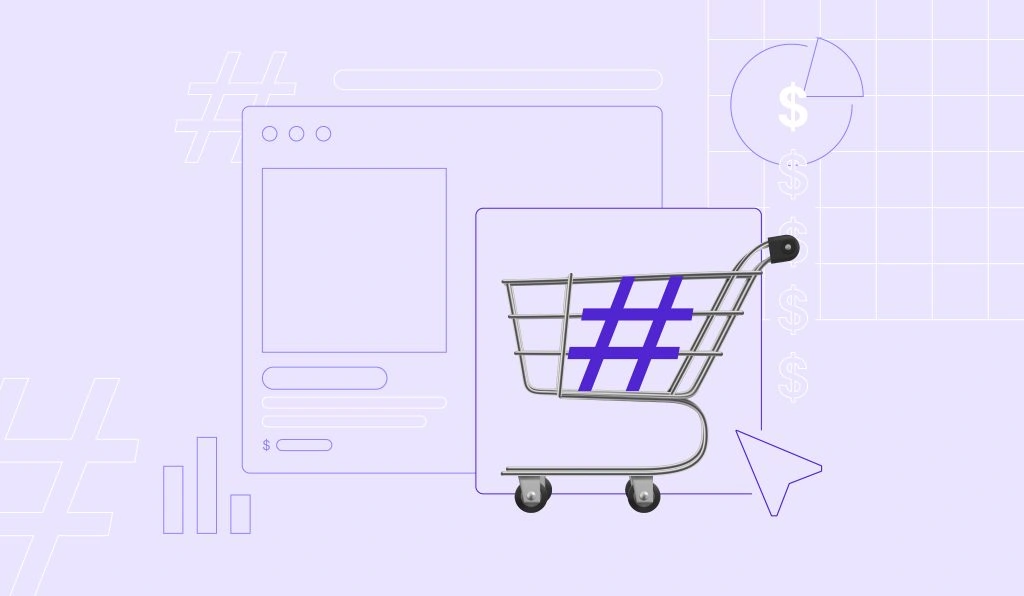How to sell clothes online and make money

Whether you’re decluttering your wardrobe or want to build a clothing brand, there are many opportunities to sell clothes online.
The problem is it can be overwhelming when you don’t know how to start.
Well, that’s why we’re going to cover a step-by-step process for selling your clothes, the best platforms for selling clothes online, and effective marketing strategies for you to start earning money.
1. Research the online market
First, you need to research the market to determine your target audience and identify current trends.
This helps you identify what your potential customers want, which means you can make informed decisions about the type of clothes you sell and how to actually sell them.
Discover your target audience
Use social media insights to gather information about your target audience’s age, gender, lifestyle, income level, interests, and fashion preferences. You can do this by monitoring fashion-related hashtags, following conversations, and analyzing similar brands.
Researching competitors and major marketplaces like Amazon or ASOS is also a great way to understand your target audience. Check out their product listings and read customer reviews to learn what people like or dislike about certain products and if they are even worth selling.
Identify fashion trends
Stay on top of the latest fashion trends by following fashion influencers on Instagram or TikTok, subscribing to fashion blogs and magazines, and observing what you see regularly at stores or events.
The more you know about your target audience and trends within your niche, the easier it will be to curate a great selection of items.
2. Select clothing items for sale
Once you’ve decided on a target audience, you need to find clothes that appeal to them.
There are many ways to find clothes to sell online, but you need to balance your goals with the time and financial investment involved.
Discover some options about how to make money fast as a woman.
Secondhand Clothing
The easiest way to find clothes to sell is if you have used clothes that fit perfectly within your niche and you’re ready to let them go. However, you need to be diligent with quality control and provide detailed condition descriptions to overcome any buying hesitations. Selling secondhand goods is also sustainable, meaning you can tailor your message toward eco-conscious customers.
Handmade Clothing
Creating your own items to sell is a great option if your target audience is into unique clothes. This can range from plain shirts that you’ve dazzled up with your own personal touch to something you’ve stitched together yourself.
This option can be time-intensive, and you are limited in scaling, but you also have the potential for higher margins when you highlight the craftsmanship and uniqueness of each item.
Wholesalers
If you’re looking to sell new clothes, you’ll need to find wholesalers at places like Alibaba and Wonnda or by attending trade shows. The downside is that you need to invest money and time into sourcing the products, not to mention the space to store them.
Start with sample orders to test quality and demand. Once you’ve established strong demand and reliable suppliers, you can start scaling your business.
Dropshippers
Dropshipping is a great alternative. This is where the supplier stores the products and sends them directly to your customers for you. Often, you’re limited to what the supplier has in stock, and you can’t easily customize the offers, but it’s a great low-cost way of testing the market.
You can find dropshippers from sites like AliExpress and Worldwide Brands. Just make sure you thoroughly vet the suppliers for reliability and quality.
Print-on-demand
Print-on-demand services like Printful and Printify are great options for customizing the products you want to sell.
You can create your own designs and apply them to ready-to-go products like hoodies, t-shirts, and even hats. Similar to dropshipping, the supplier will deliver your products to your customers directly.
3. Choose an online selling platform
Two of the most common options are selling clothes through popular online marketplaces or on your own website.
Online marketplaces make it easy for you to reach potential customers and start selling quickly as they already have an established user base. However, the downside is that most platforms charge listing fees, which can eat into your profits, and there is often a lot of competition, which makes it a challenge to stand out.
On the other hand, building your own online store gives you full creative freedom to build a website that matches your vision, you don’t have to pay listing fees, and you don’t face competition on your own pages. Many sellers start out on online marketplaces to gain experience and build a customer base before transitioning to their own online store.
Top online marketplaces to sell clothes
While there isn’t one best place to sell clothes online, these 5 online marketplaces offer a wide audience for you to target.
Vinted
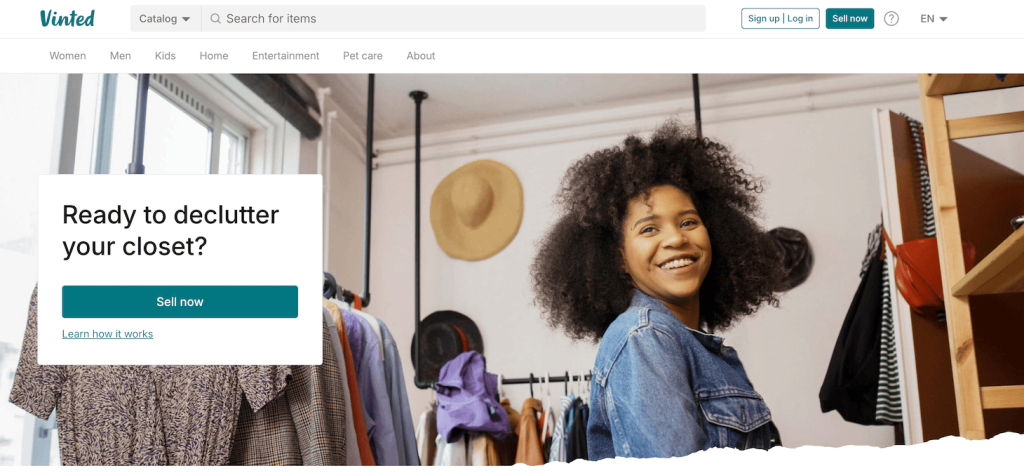
Best for: Casual sellers who want to clear out their secondhand clothing
Vinted is an easy-to-use marketplace where people buy and sell used clothes. It’s a great place to sell your used clothes if you have high-quality items in your closet that you’re ready to let go.
To start selling with Vinted, create a profile and provide basic information. You need to take clear photos and write engaging descriptions for each of the items you want to list. Once an item sells, they provide you with a shipping label to make it easy to ship it out.
The best thing about this platform is there are no selling fees, meaning you keep all the profits.
Pros:
- There are no selling fees. Buyers are charged with a service fee instead.
- It has an easy-to-use interface, so even non-techy sellers can do well here.
- A large European user base gives you a wide audience to sell to.
Cons:
- There are a lot of sellers, so you might need more unique items to stand out.
- It’s not as popular in the US, which could be a limitation for sellers based there.
Depop
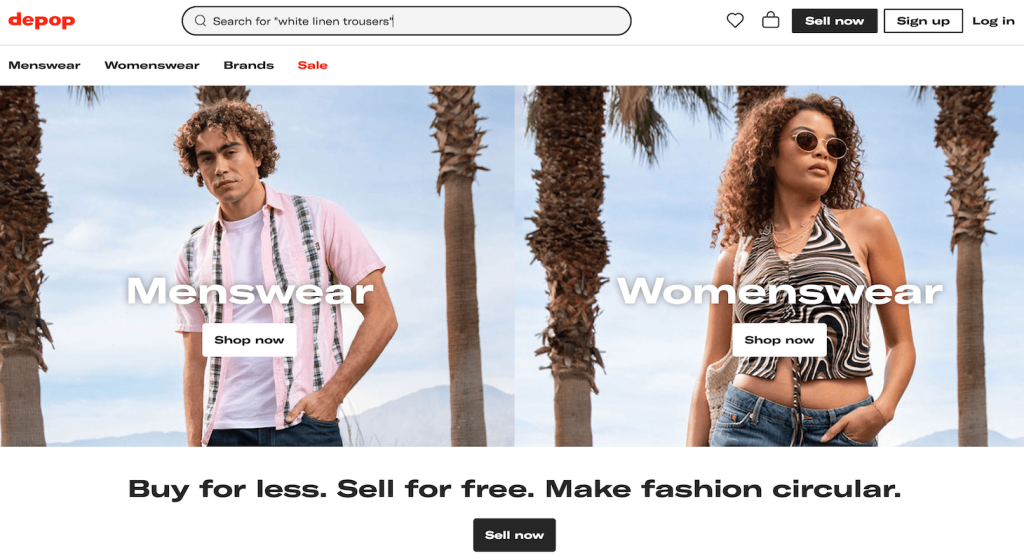
Best for: Sellers targeting a younger crowd with trendy items
An app-based marketplace geared towards a younger crowd, this is the place to be if you have trendy or unique items.
The setup is simple with Depop. First, download the app, register, and create a profile. For your listings, you can provide up to four photos and a detailed description.
Posting regularly and gaining followers and likes on the app are important for success. You can also take advantage of the dedicated seller team to learn how to sell more on Depop.
Pros:
- A large and engaged younger audience makes it ideal for selling trendy items.
- It’s an intuitive platform to use that will feel familiar to most people.
- The supportive community and dedicated seller team are great for improving sales.
Cons:
- The 10% selling fee plus PayPal fees can eat into your profits.
- The younger demographic might not be ideal for all types of clothing.
Poshmark
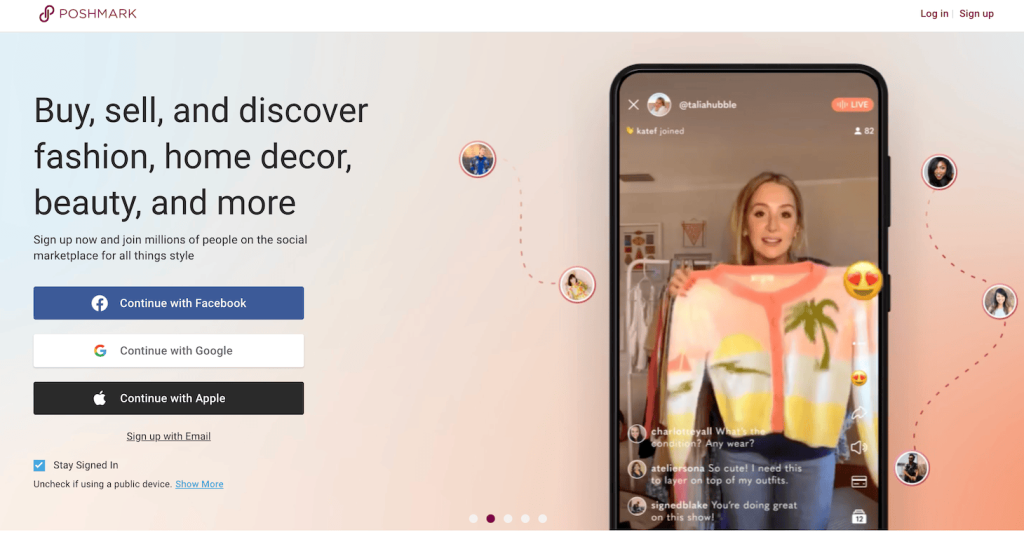
Best for: Fashion-savvy sellers with mid to high-end brands on offer
A social marketplace with a vibrant community, Poshmark is perfect for those who enjoy the social aspect of selling clothes.
The app makes setting up and creating a profile easy, and you can create listings within minutes.
Active engagement in the community and participating in Posh Parties, which are real-time virtual shopping events themed around specific brands or styles, help boost sales.
Pros:
- An engaged and active user base provides a large audience to sell to.
- Simple shipping process with the pre-paid, pre-addressed labels for each sale.
- Significantly boost visibility by using social features effectively.
Cons:
- There are high fees, with 20% for sales above $15 and $2.95 for sales under $15.
- The audience is predominantly US-based, which could limit international sellers.
ThredUp
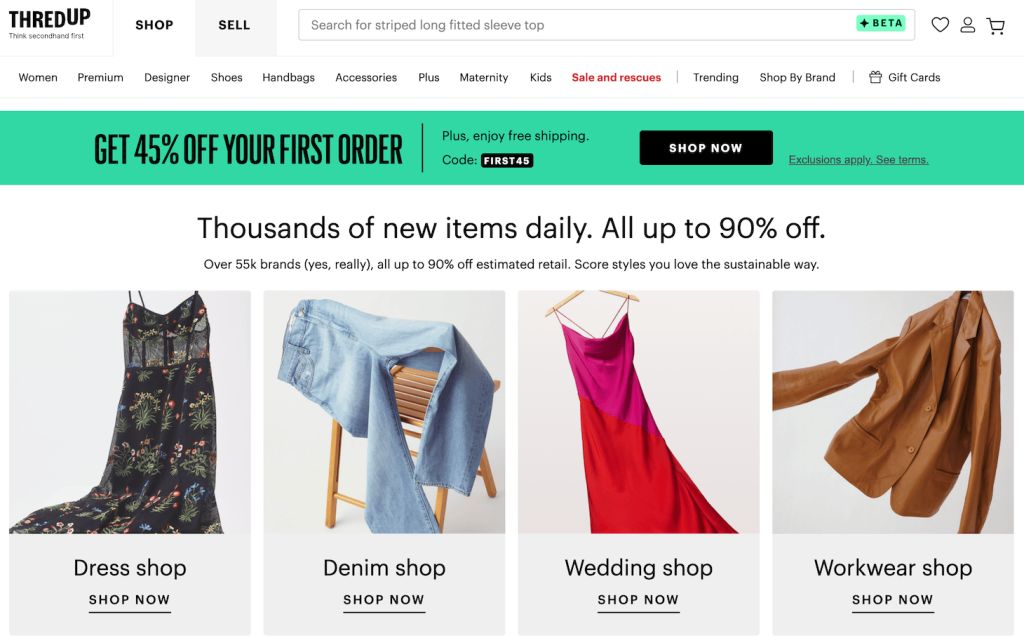
Best for: Sellers who prefer a convenient approach to selling
An online consignment shop, ThredUp is a full-service provider that handles everything in the selling process, from photography to pricing and even shipping. Perfect if you want a hands-off selling experience.
You get started with ThredUP by ordering a Clean Out Kit. You fill the bag with clothes you want to sell and send them back to ThredUP. They process the items, decide what to accept, and list them for sale. All you do after that is receive payment for the items they sell.
Fees vary depending on how quickly you want your items processed, ranging from $14.99 for regular processing to $25.98 for two-week processing.
Pros:
- Minimal effort is required on your side, which is ideal if you’re short on time.
- If you want to sell many items, you don’t need to create individual listings for each one.
- Their clear payout policy based on brands means you know how much you can earn if they accept your clothes.
Cons:
- You will earn much less compared to selling the clothes yourself.
- They do not accept clothing items that are not from accepted brands or are not in excellent condition.
Etsy
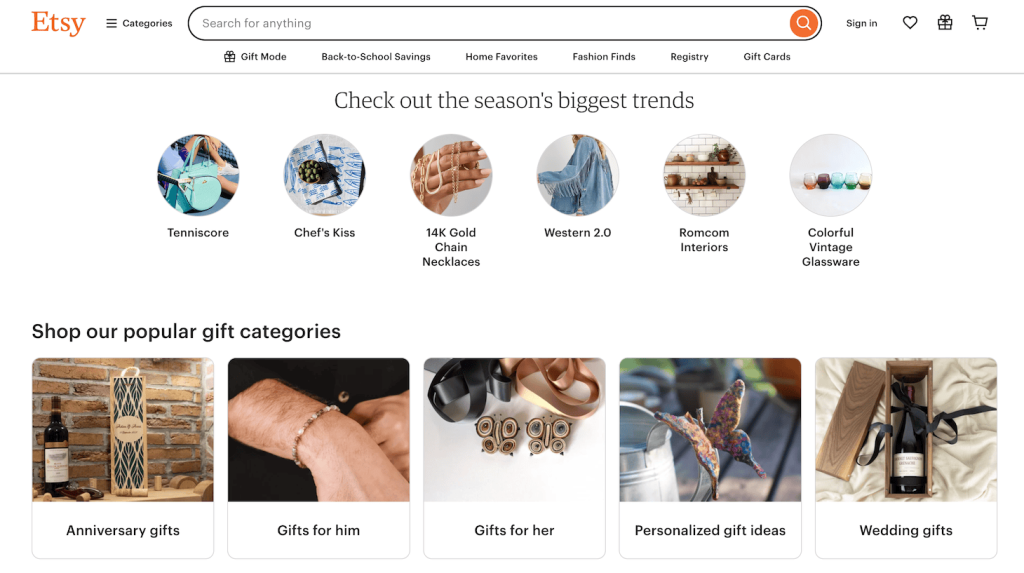
Best for: Sellers of handmade, vintage, or customized clothing
Renowned for its community of independent creators, Etsy is a great online marketplace for handmade or vintage clothing.
Getting set up on Etsy is a bit more involved than on the other platforms. Creating an account is easy, but you need to be thorough with your branding, photos, and descriptions to stand out. You will also need to set your own shipping rates and policies.
Pros:
- You have access to a huge customer base that is specifically looking for unique items.
- It’s an ideal platform for those who want to build a distinct brand.
- A range of tools are helpful for marketing and managing your clothes.
Cons:
- It might not be a suitable platform for regular secondhand clothing as most buyers there are looking for handmade items.
- Listing fees, transaction fees, and payment processing fees all impact your profitability.
Using an online store
Online marketplaces are an easy way to get started, but creating an online store might be a better option if you want to have more control over your own brand and products.
While there is a lot more involved in setting up your own store, there are some great benefits:
- You have complete control and freedom. Create an eCommerce website that perfectly matches your vision and branding.
- You don’t have to pay platform fees. Keep more of your overall sales revenue.
- You aren’t restricted by marketplace restrictions. Offer new products without seeking approval from marketplaces.
- You own marketing data. Create personalized marketing campaigns that use customer data such as email, purchase history, and browsing behavior.
- You won’t face any competition on your own pages. Customers only see your products instead of being distracted by similar items on offer from competitors.
Creating a website can sound intimidating, especially if you’ve never done it before. But using Hostinger’s online store creator, you can set up your clothing business in minutes with the help of AI, a simple drag-and-drop editor, and a host of powerful eCommerce tools.
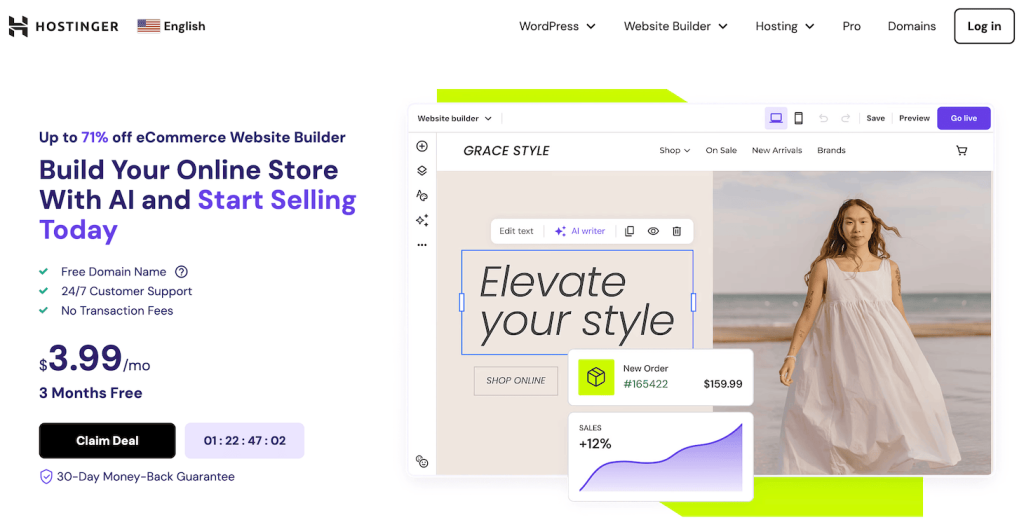
Read our tutorial on how to create an online clothing store to learn more.
4. Write compelling product descriptions
Whether you’re selling clothing on online marketplaces or building your own online store, you need to craft engaging and informative product descriptions.
You don’t need to write like a best-selling author here, though; you just need to highlight what makes your items special.
- Focus on describing how the fabric feels. Mention whether your clothes have special design elements or use specific materials and why that could appeal to your potential customers.
- Be sure to provide specific details. Include all the sizing information and any special care instructions while also being transparent about any imperfections or limitations. Address all the questions that will come up for anyone who comes across your products.
- Keep readability and SEO in mind. Use bullet points to break up your text and simple descriptive words to improve readability. Be sure to incorporate relevant keywords to increase the visibility of product listings as well.
- Don’t forget about your target audience. Craft your titles and descriptions in a way that resonates with your target audience by using the words and phrases they would use and connect with.
With Hostinger Website Builder, writing great product descriptions for your online store is quick and easy. Simply upload an image of your product and let AI create your product descriptions for you. This innovative feature saves you time and effort, especially if you want to list multiple items.
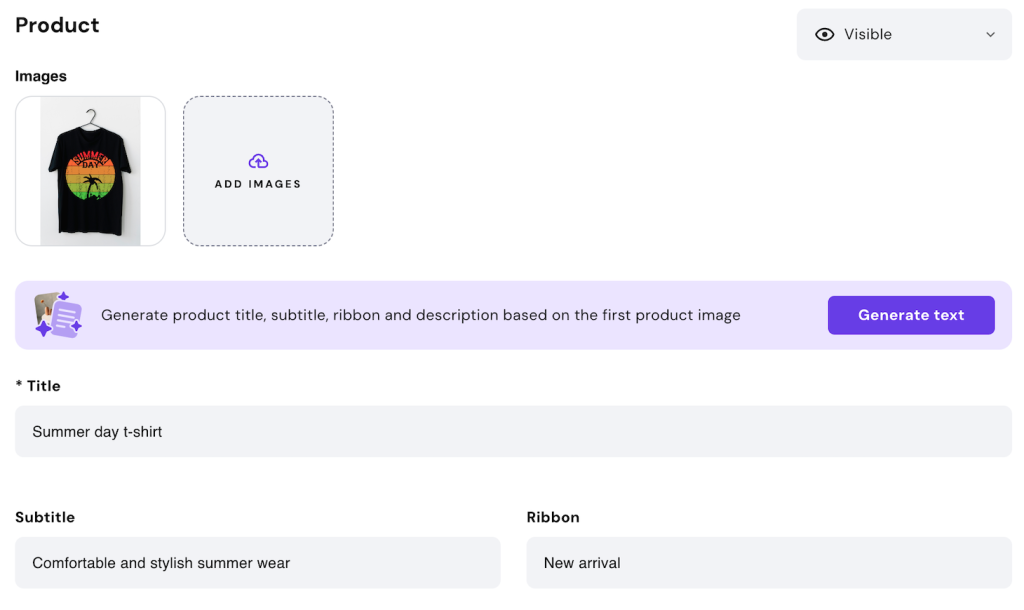
5. Take high-quality product photos
In addition to having great product descriptions, high-quality photos are equally important.
You want your photos to pop off the page and grab people’s attention. That way, they’ll be interested enough to stay on the page and actually read through the description.
So, what makes for great photos?
- It starts with the right equipment. You need a high-resolution camera or at least a phone with a decent camera. If you want to add a more professional touch, consider purchasing a tripod.
- You also need a nice background. A neutral-colored wall would be best, but what also works is if you’ve got a setting that fits with the niche of your clothing. For example, you’ve got a beach as your background, and you’re selling Hawaiian shirts.
- Remember proper lighting. Use natural lighting whenever possible, but if you need to use artificial lighting, softboxes or ring lights work well, as they help avoid weird shadows and overexposure.
- Take photos from multiple angles. Shoot the front, back, side, and close-ups of texture or certain details in the clothes. All of this is important and helps to paint a picture in the customer’s mind of how the item actually looks.
- Edit your photos to help them stand out. Many simple photo editing apps can help you adjust brightness, remove elements in the background, or crop photos to focus more on the product. There’s no need to go overboard with it; just give your products the limelight they deserve.
Taking amazing photos that go well with an engaging description will go a long way to helping you sell clothes online.
6. Set up pricing for online selling
While there isn’t an exact way to know how much you should sell clothes for, you can research your competitors to see what prices they are offering for similar items. This will give you a good pricing range to work with.
The actual price you end up going with should depend on different factors.
- Calculate your costs. Your pricing strategy will need to account for costs such as sourcing your clothes from a manufacturer, shipping costs, and the fees charged by online marketplaces.
- Consider any unique value. You can also adjust your clothing pricing strategies based on whether your clothes use special materials, have ethical production methods, or even if there is something exclusive about them.
Keep in mind that you don’t need to settle on a certain price. The best approach is to set a price based on your current research and then continue to review and adjust it based on your experience, market trends, and seasonal sales.
With Hostinger Website Builder, setting and adjusting prices for each product is easy.
The simple pricing dashboard allows you to update an item’s price and present a discounted price if necessary.

Meanwhile, setting variable and fixed-amount discounts that apply to all products is a convenient feature for major sales events like Black Friday.
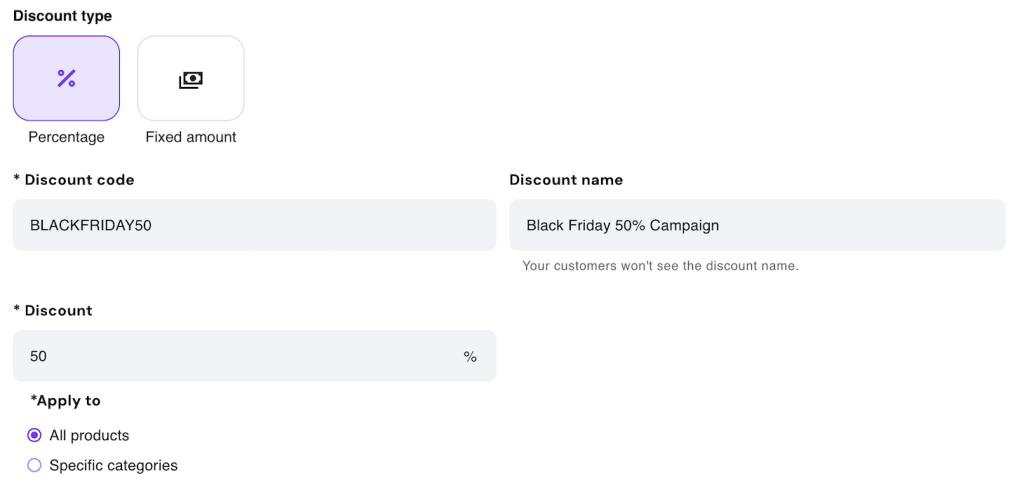
7. Market and promote your clothes
Once you’ve got your listings set up, it’s time to promote your clothes.
Platform-specific promotional tools
If you’ve listed your clothes on a third-party online marketplace, the easiest way to promote your items is to use their built-in marketing tools.
Platforms like Etsy, Vinted, and Depop allow you to run ads to boost your listings in the search results, while Poshmark allows you to participate in virtual shopping events that help increase your items’ visibility.
This is a great way to leverage the existing audiences on these platforms. Just be sure to tailor your approach to match the typical user on each site.
Other effective marketing strategies
These platforms are great for a boost in visibility, but you shouldn’t rely on them completely. You need to also do your own marketing to drive traffic to your website, especially if you want to build your brand.
Depending on how much time and resources you want to invest, some of these might be appropriate for your situation, while others might not.
Here are a few effective marketing strategies to try out:
Instagram:
- Put those photos to use. Post a mix of high-quality product photos and lifestyle shots showcasing your clothes in real-life situations.
- Be consistent and unique. Remember to also post Stories and Reels, where you can provide styling tips, fashion hacks, and more unique content that helps you stand out.
- Research popular and niche-related hashtags. To reach your target audience, use a combination of broad and specific hashtags, such as #styleinspo and #vintagestyle.
Pinterest:
- Create boards for different styles. Organize your pins by themes, such as Vintage Clothing or Designer Clothes, to make it easier for people to find what they’re interested in.
- Optimize pin descriptions. Include targeted keywords in your descriptions to help people find your pins more easily.
- Collaborate with similar accounts. Partner with other Pinterest users who have a complementary audience to create joint boards, gaining greater exposure for your pins.
TikTok:
- Participate in current trends. Create content that takes advantage of current trends, or create your own niche-specific challenge to increase engagement and visibility.
- Show behind-the-scenes content. This is especially effective with handmade and vintage items, where users get access to your unique designs.
- Use the right hashtags. Instead of just using the most popular hashtags on your captions, use tags that are relevant to your content.
Influencer Marketing:
- Start with micro-influencers. Partner with influencers who have about 10,000 to 100,000 followers, as they will often have more niche-relevant audiences with higher engagement.
- Provide unique discount codes. This allows you to track performance and focus on the partnerships that are bringing the best results.
- Create limited edition offers. Collaborate with specific influencers to create exclusive items, leveraging their personal brand and generating buzz for your clothes.
Email Marketing:
- Build a list of potential buyers. Offer a discount to encourage sign-ups, particularly for first-time buyers, and promote sign-up forms on social media.
- Segment your list. Group subscribers based on factors like purchasing frequency, products they’re interested in, and engagement level.
- Create segment-specific newsletters. Send a mix of product features, style tips, and exclusive offers to keep subscribers engaged with what they are specifically interested in.
Tips for creating engaging content
If you’re creating your own content, it’s also going to take some time and effort. So, here are some tips to help you stand out:
- Focus on lifestyle shots. Showcase your clothes being worn in real-life situations.
- Be unique with video content. For example, create unboxing videos, styling tutorials, and behind-the-scenes content.
- Give advice. Talk about fashion trends, styling tips, and care instructions for your clothes
- Encourage user-created content. Ask customers to share photos wearing your clothes and feature them everywhere.
- Use AI to help you. Leverage tools like AI Writer in Hostinger Website Builder to create video scripts, captions, posts, and more.
- Stay organized. Create a posting schedule, and stick with it!
Marketing involves a lot, but with a solid plan, diligence, and a dash of creativity, you can achieve amazing things.
8. Decide how to handle orders, shipping, and returns
Now, with all that great marketing you’re doing, you also need to start thinking about how you’re going to fulfill those orders.
The best thing to do here is to be as organized as possible. This starts with setting up automated notifications for yourself and your customers.
- For customers. Set up automated order confirmation emails that customers receive when they make an order so they know you received their order.
- For yourself. Set up automated notifications so you know when someone makes an order. That way, you know when to fulfill the order.
You also want to make sure you’re prepared before any sales come through for the actual order fulfillment process.
- For managing inventory. If you’re selling handmade clothing or your own used clothes, a simple spreadsheet or inventory apps like Sortly or Stock and Inventory Simple will help you keep track of available items. If you’re working with a supplier, use an online platform that lets you connect to their databases so your listings can update as soon as the supplier updates their inventory.
- For storing and picking. It’s best if you have a designated area where you store your items and can easily organize clothes for shipping.
- For packing. To minimize costs, choose lightweight mailers that are the right size for your clothes, and have a few small boxes available for any bundled orders. Consider eco-friendly packaging if that appeals to your niche.
- For a personal touch. Personal thank you notes in the packaging help you to stand out and create a memorable unboxing experience. You can prepare these in advance by writing them out or printing cards with a nice message.
- For sending. If possible, use a prepaid shipping label with the customer’s details to ensure the package is completely prepared before you take it to the post office.
Before you handle shipping, you need to research and compare service providers to determine the actual cost. Keep things simple. Offer standard and expedited shipping.
Finally, you need to develop a clear return policy that is both customer-friendly and fair for you.
- A 30-day return window is standard. Based on the time it takes to process returns, decide what works for you.
- For new and used clothes. Make it clear that they can only be returned in the same condition.
- For handmade clothes. Decide if you accept returns, especially on custom orders.
- Consider free returns. In most cases, customers have to pay for return shipping, but when you’re starting out, you might want to consider offering free returns to build trust and rapport.
- Decide on the appropriate refund time. Specify clearly that refunds will be processed within a certain timeframe after you receive the item back. Typically, this is up to five days.
While most third-party platforms will have a lot of these features built-in, you can customize the process to fit your own needs.
If you set up your own online store, there are a lot of different ways to do it. With Hostinger Website Builder, you can easily track your inventory and orders using powerful eCommerce tools.
9. Track Sales Performance
Just as you would track the number of orders you receive, you should also regularly analyze your sales data.
Why you should track and analyze sales data
Your sales data will give you a more in-depth understanding of your customers’ behavior, which will, in turn, inform your decision-making regarding how to grow your business.
The data can show you which clothes are popular with your audience, which marketing channels drive the most sales, and how effective your product listing pages are.
All of this helps you to focus on what’s working and improve what isn’t.
So, how do you actually see this data?
How to track sales performance
Most eCommerce platforms offer their own analytics tools that show you basic sales data and insights. If you’re running a small operation, this might be enough to know which clothes are the most popular and to double down on them.
For your own online clothing store, Hostinger Website Builder also provides valuable data insights, allowing you to dive deeper into your store’s performance.
What you need to track
There are many data points you can examine, but it’s important to focus on the main ones that will offer you the best insights for decision-making.
Here are several of the most important ones to keep an eye on and how they can help you:
- Total sales volume. You can track sales volume monthly to get an idea of how your business is performing overall. If the data shows there is seasonality, you can consider adjusting your marketing or your offers to match.
- Customer lifetime value. This shows the total revenue you can expect from each customer over the lifetime of their relationship with your business. This can indicate whether your customers only make one-time transactions or they keep coming back to you over time.
- Customer acquisition cost. If you’re investing in paid advertising, this will show you how much it costs to acquire each customer. Ideally, the number should be lower than the customer’s lifetime value.
- Conversion rate. This is the percentage of visitors to your page who make a purchase. You can try to increase conversion rates by writing more engaging descriptions, taking better photos, or driving more targeted traffic.
- Bestsellers. Identify which of your products are most popular so you can offer more of the same or complementary products, which will entice your customers to purchase more.
- Return rate. This is the percentage of items sold that are returned by customers. A high return rate can indicate issues with the quality of clothes or inaccuracies in product descriptions. Either way, see it as an opportunity to improve what you offer.
Conclusion
Selling clothes online requires a combination of effective marketing strategies and attractive products. By following the steps outlined here, you will be well on your way to decluttering your wardrobe or building a new clothing business.
Here’s a quick recap:
- Research the market and analyze current trends to pinpoint your ideal customer.
- Decide how you will source clothes to sell to your audience
- Choose where you will sell clothes online. Two common options are on popular online marketplace or with your own online store.
- Write informative product descriptions that highlight what makes your items special.
- Take high-quality product photos that grab people’s attention.
- Set your prices based on research and take into account your costs.
- Promote your clothes through platform-specific tools, social media, and email marketing.
- Decide on a reliable way to handle orders, shipping, and returns.
- Track and analyze your sales data to help make informed decisions for the future.
With the right tools, a good amount of preparation, and dedication, you can achieve a lot. We hope this guide has helped you gain the confidence to start selling clothes online.
Frequently asked questions
Which platforms are best for selling clothes online?
While there are many great online platforms for selling clothes, the top five are Vinted, Depop, Poshmark, ThredUP, and Etsy.
How much can you make selling clothes online?
There isn’t a simple answer to that. It depends on many factors, especially the types of clothes you’re selling, the demand for them, and what your goals are.
If you’re looking to sell everyday clothing that you no longer wear, then your earnings will be limited by how many items you want to sell.
On the other hand, if you’re looking to start a clothing business, your income will vary from a nice little side income to, hopefully, a lot more. But again, this will require much more time, effort, and investment.
There’s a lot involved in selling clothes online, so you need to align your ambitions with how much involvement you can commit to.
Can social media help boost my online clothing sales?
Absolutely, social media can help you sell clothes online. It’s a great way to reach your audience by consistently posting great content and engaging with potential customers.
There are a lot of great social media platforms, so you need to consider which ones might be best for your clothing items and your particular niche.


